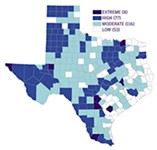Rethinking Downtown Zoning
Proposed changes address sustainability, mixed uses, and urban design
By Katherine Gregor, Fri., April 2, 2010
Perhaps the most sweeping change recommended: allowing mixed-use projects throughout Downtown. (The only exception would be in areas zoned "single family.") The goal is to create a more vibrant urban experience and streetscape for shoppers and pedestrians, with redeveloped properties transforming dead zones – such as drive-through banks, parking garages, or big office building facades. Downtown mixed-use zoning would feature different heights matched to specific districts.
At a March 17 presentation to the local chapter of the Congress for the New Urbanism, McCann said developers, owners, and the real estate community want a simpler code. Discussion focused on whether the new rules move the city far enough toward a form-based code – an approach that regulates building form and streetscapes to ensure compatibility but doesn't dictate uses. "We feel like current zoning standards do a really poor job of providing for compatible buildings," said McCann. But the draft regulations do limit uses – for example, a ground-floor architectural office wouldn't be allowed in a historic building on Congress Avenue or Sixth Street. Several CNU members advocated that if the code gets the building form right, the market should be free to generate the uses.
The same issue was raised March 25, when McCann Adams presented the proposed regulations at a Downtown Austin Alliance "Issues and Eggs" breakfast. "On non-core retail streets, you ought to allow more flexibility, rather than specify allowed uses at ground level," suggested real estate analyst Charles Heimsath. "If you require height and transparency, then you ought to let the market determine what locates there." Adams responded, "Other cities incent desired uses, from an economic development standpoint."
"Are you going to compensate private property owners for rights you take away?" asked appraiser Leroy Eide. To which Adams replied: "We're not down-zoning any properties. We are trying to increase the value, across the board." He noted that public-sector investments, such as those recommended in the Downtown Austin Plan, consistently are shown to increase property values, by about 15% to 20%. To implement the plan successfully, the consultants recommend formation of a Downtown development corporation that could create investment partnerships. In addition, said Adams, "Retail recruitment has got to continue in a really vigorous way." The draft regulations and presentation are at www.cityofaustin.org/downtown.
Got something to say on the subject? Send a letter to the editor.









